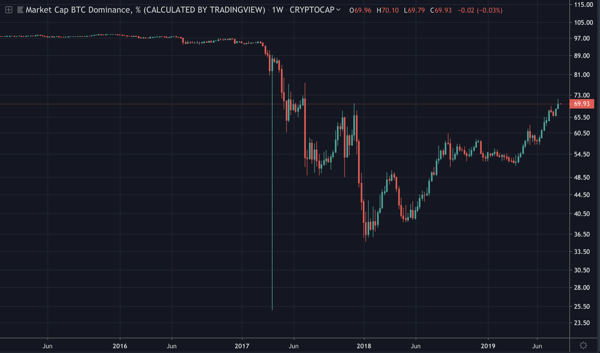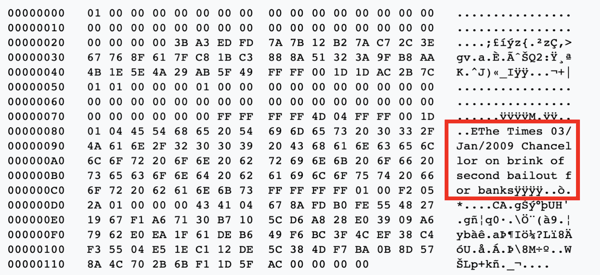Please note, this week's That's Our Two Satoshis is written by Arca Trader, Sasha Fleyshman.
What happened this week in the Crypto markets?
Bitcoin Giveth, and Bitcoin Taketh Away
Gone are the days of alt season when digital assets not named Bitcoin thrived. This was so long ago (albeit in crypto time) that there is now a growing sentiment that that season never return.
Ethereum was initially released on July 30, 2015, although it lay dormant to early adopters for years. Alt-season was birthed by the creation (and advancement) of what is now the second largest digital asset, Ethereum. Although other coins besides Bitcoin the leading cryptocurrency existed pre-Ethereum (Litecoin, Peercoin, Dash, Ripple, and Monero, among others), the space was by and large dominated by Bitcoin.
Fast forward to early 2017, when the digital asset space as a whole began to gain significant real-world traction. Ethereum led the charge for alternatives, rapidly increasing in both price and notoriety. The resultant crypto “Cambrian explosion” can be attributed to this increase, as the number of unique digital assets ballooned from 636 to 1,353 during 2017 (currently at 2,440). Ethereum played a significant role in serving as the blockchain for these nascent decentralized applications (dApps).
Over the course of 2017, this resulted in a massive (relative) capital inflow into the space, mainly from the now defunct ICO craze. Bitcoin’s market dominance was effectively diluted as the total size of the crypto market expanded rapidly with new tokens created out of thin air causing the circulating supply split from realistic liquidity expectations:

Since the peak of the “bubble” - a generic term to depict market euphoria - we have seen market dominance flow heavily back into Bitcoin. While the above chart may not look impressive, it is worth noting Bitcoin now has the same market share against a much larger universe ($290M market cap, August 2019), whereas before Bitcoin dominated the market share in a tiny overall asset class ($45M market cap, May 2017). The growing regulatory concerns of new tokens’ creation and existence along with the turbulent market over the past 18 months led many portfolios to consolidate into Bitcoin. This is healthy for the market - many of the tokens that were once perceived as market darlings were akin to a house of cards - the reality (or lack thereof) of their gaudy promises is slowly setting in.
Save for a few outliers in the digital asset space, all eyes have been (and will continue to be) on Bitcoin for the foreseeable future. It will not always be this way, but market environments are mercurial; the market must react in-kind or be left behind.
The “What” and “Why” of Bitcoin
As Bitcoin and the rest of the digital assets space continue to permeate the minds of those in traditional finance, the “5 W’s” of Bitcoin have been largely ignored. While there is great focus on the “When” - as in, “When is the right time to invest?” - the “What” and “Why” of Bitcoin have not been at the forefront of discussions. Last week, we went into detail on the weakened global macro backdrop and how the conditions of this specific environment double as a potentially perfect incubator for Bitcoin. For many, this answers to the “When” question; when = now. Touted as a capital flight instrument and a safe haven for wealth, Bitcoin has been at the forefront of the majority of these discussions throughout the last few weeks. So much so, in fact, that it raises the question: “As Bitcoin occupies the headspace of many at a continuously alarming rate, is there something to be said about the massive gap in relative value of Bitcoin compared to other safe haven assets that have taken a back seat in discussions?”The general consensus is that while many have heard of Bitcoin, it is far different from what they are used to. Bitcoin is a large, confusing pill to swallow, and this confusion leads to negative connotations of the space. We have all heard naysayers designate Bitcoin as “fool’s gold”, criminal money, funny money, a scam, and a bubble, among others. These designations, for the most part, come from a lack of understanding on the “What” and “Why” of Bitcoin. While these explanations are subjective, there is consensus on the core values which help paint the full picture of this space.
Answering the “What”
What is Bitcoin? What is Bitcoin trying to accomplish? What is it trying to improve upon?
This is a loaded question since Bitcoin isn’t trying to do anything - Bitcoin just is. The use cases of Bitcoin are dependent on the user - some see Bitcoin as a store of value, others as a medium of exchange, and others as an all-encompassing ‘sound money’ designation. Instead of arguing the semantics on whether Bitcoin or Bitcoin investors are trying to accomplish something, we will try to lay out the basic framework for how a person can decide their own “What”.
What Bitcoin offers is a clean split of “trust” from money - the separation of money and state. Those who believe in Bitcoin as “sound money” see it as a solution to the overbearing problems in the current financial landscape, in which, one does not control their own finances (maybe at face value, but not at its root). The value proposition of Bitcoin can be broken down into a few components:
- Hard-capped Supply - only 21,000,000 BTC will ever be in circulation. There is no way to print more Bitcoin without destroying the essence of Bitcoin.
- Deflationary - Block halvings reinforce the idea of a hard-capped supply, with daily issuance of Bitcoin splitting in half every 4 years as it approaches zero (the decay rate of such a limit places the finality of new issuance around the year 2150).
- Censorship Resistant - There is no single entity that controls emission, payment channels, or any other type of financial freedom. The funds that one owns is their’s to control and use as they see fit.
- Immutable - There are no chargebacks or attack vectors for fraud and/or manipulation.
For this reason, the “When” of Bitcoin is of little to no importance for those already in the space since the answer is trivial: always.
Answering the “Why”
Why was Bitcoin created? Why is Bitcoin still around? Why was there ever a need for a digital asset with the aforementioned components?
We first have to look at the Financial Crisis of 2007-2008 - touted by many economists as the worst financial crisis since the Great Depression. Fractional reserve banking, rehypothecation of consumer funds, and the general trust of the world in a few large institutions has led to a financial fallout that reverberated globally for over a decade. This event was met with disgust from those behind both the creation and early growth of Bitcoin, who witnessed the failures of these large institutions that left the general public to suffer from the repercussions.
When the Bitcoin whitepaper was published on October 31, 2008 by pseudonymous creator Satoshi Nakamoto, it came with the vision that we needed “a system for electronic transactions without relying on trust”. When the first block of Bitcoin (the Genesis block) was mined, embedded within was text from The Times, offering a tactile data point as to the motivation behind Bitcoin’s creation.

As we now find ourselves in a macroeconomic landscape comparable to that of 2008, it is of no coincidence that Bitcoin is once again bubbling to the surface of discussions. How each and every one of us feels about current market conditions is the answer to the “Why” - because it is necessary. The idea of Bitcoin was shaped as an antithesis of the current financial system, and at present, offers portfolios around the world insurance should the current economic conditions lead to another collapse. Simply put, Bitcoin (and other safe-haven assets) offer protection against calamity.
Notable Movers and Shakers
As macroeconomic conditions worsen around the world, Bitcoin continues to make steady gains as an uncorrelated asset (+5%), with market dominance trickling up towards 70%. Alternative assets trickled down for most of the week, with a few notable exceptions:
- Algorand (ALGO) was approved to list on Coinbase Pro on Wednesday, according to the company’s blog post on Friday. This particular project has been in the news quite a bit as of late, most recently offering an early redemption period to those who invested in their Dutch auction in June. Hitting the press has worked for them as of late, as their token finished +16% on the week.
- Binance (BNB) announced the tokens they plan on listing for their new US-based exchange in a blog post on Friday, granting a little more clarity for those worried about the coming crackdown on U.S. users, which they announced would happen in September. A large concern was that BNB would not be available to U.S. customers, and as such the market reacted favorably to the blog post, with BNB finishing the week up 9%.
What We’re Reading this Week
Copycats Galore
Anthony Pompliano of Morgan Creek Digital hosted Kyle Bass, Founder and CIO of Hayman Capital, on his podcast a few weeks ago. The two discussed how Bass identified the housing market crisis before it happened and the deteriorating global macro environment, including what’s going on in Hong Kong, and institutional hurdles for Bitcoin investments.
The Federal Reserve last week announced it was going to begin exploring building a 24/7 payments system, called FedNow. Such a system would mean that payments could be made round the clock at any time of day and would provide instant settlement. Although not explicitly referred to, such a system would likely use some form of blockchain technology to deliver such fast settlement times. All “FedCoin” jokes aside (unlikely they will issue a coin), this is a big shift for the Federal Reserve, one which likely stems from fears of falling behind as the broader finance sector moves to modernize.
Last week tZero, the Overstock-backed online security token trading platform, was awarded a patent for the recording of trades on a blockchain. Without getting too technical, the patented technology allows tZero to record trade data in the hashes of public blockchains, storing the data permanently. The technology is a step in the right direction to moving the legacy financial system to blockchain-based solutions.
Mastercard last week announced it was launching a blockchain tracking solution to combat fakes in the luxury fashion industry. The product, called Provenance, is to be demoed during an upcoming fashion showcase with Fred Segal Sunset and MADE. Provenance, will not only track the authenticity of goods, it will help reduce the reported $323b in losses due to online purchases of counterfeit goods.
And That’s Our Two Satoshis!
Thanks for reading everyone!
Questions or comments, just let us know.
The Arca Portfolio Management Team
Jeff Dorman, CFA - Chief Investment Officer
Katie Talati - Head of Research
Hassan Bassiri, CFA - PM / Analyst
Sasha Fleyshman - Trader
Wes Hansen - Head of Trading & Operations
To learn more or talk to us about investing in digital assets and cryptocurrency
.jpg)

